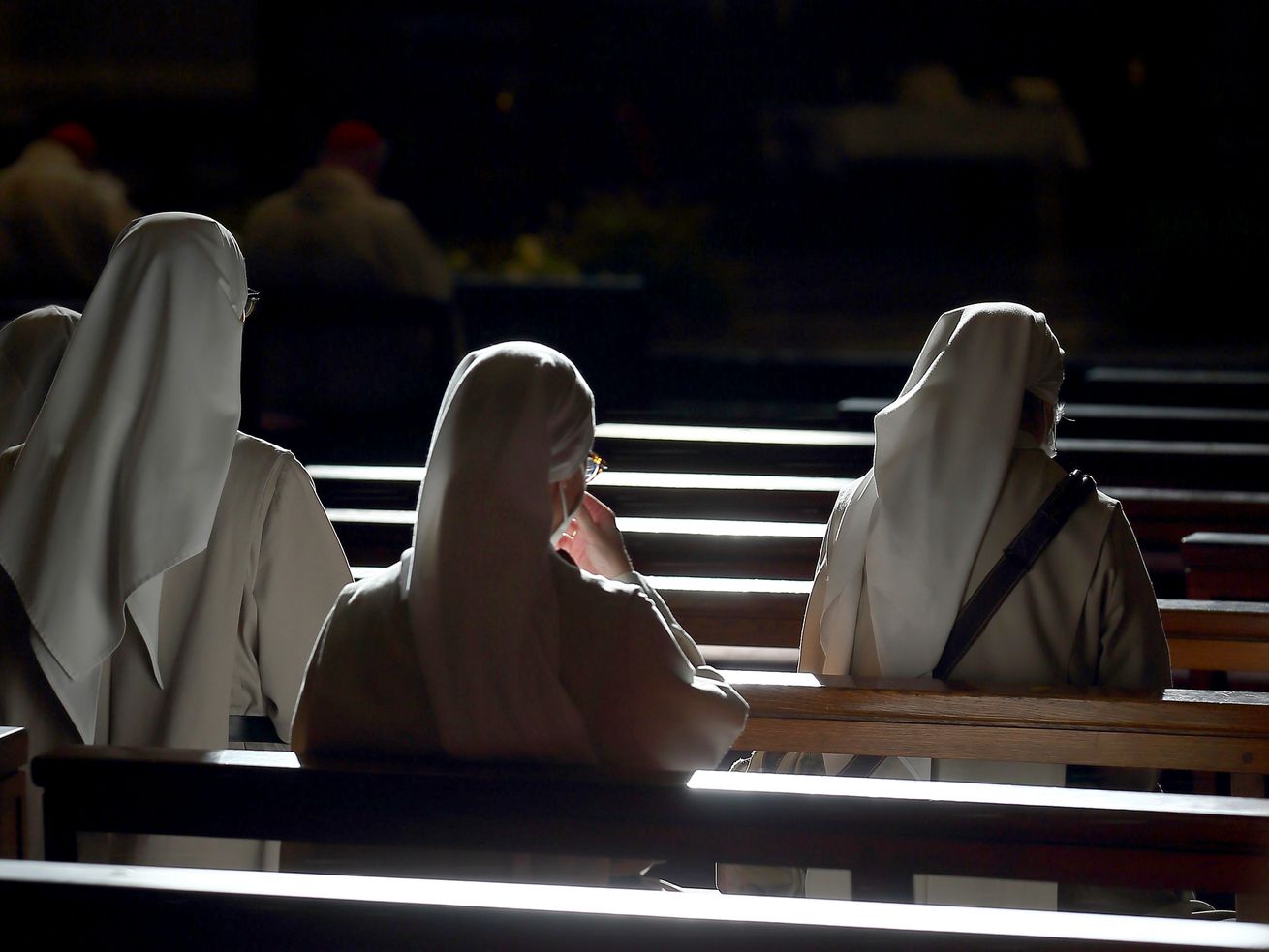The National Book Award-nominated novel brings the swaggering brilliance of 12th-century poet Marie de France to towering life.
The Vox Book Club is linking to Bookshop.org to support local and independent booksellers.
Two years ago, I saw a book at a library exhibit that once belonged to a medieval nunnery. It was a fat, old tome on the history of the popes that looked unspeakably dull, and it was open in its display case to the entry on Pope Joan, the apocryphal figure who was thought to have disguised her gender and become pope in the Middle Ages.
The nuns who owned the book were evidently fascinated by this legend. In the margins next to Pope Joan’s entry — in firm, enthusiastic script — one of them had written the words “papa femina.” Female pope.
I’ve thought of that book often in the time since: all the frustration, the palpable yearning after some sort of power or independence, packed in those two scribbled words. To be a woman living a life as circumscribed as that of a medieval nun, such that your every waking moment would have a task assigned to it, to live a life of such intense drudgery — and to still think, “There, there, there’s the proof. It doesn’t have to be like this. You can still imagine something else.”
You can imagine a woman as God’s emissary on Earth, ruling over every country and fiefdom in Europe. You can imagine not even becoming the pope yourself but just seeing another woman as the pope. Seeing her there, and knowing it was possible to reach that sort of power. Think of the thrill.
Lauren Groff’s Matrix, a finalist for the National Book Award and the Vox Book Club’s October pick, embodies that fantasy once again. It takes the scraps we know of the real-life poet Marie de France, the possibilities we can imagine for a community of women on their own, and it builds a whole utopian world from them.
The historical Marie de France was the first known woman to have written French-language poetry. She lived in 12th-century England, was probably born in France or an independent region that has since become part of contemporary France, and seems to have been known at the court of King Henry II of England and Eleanor of Aquitaine. (You might remember those particular royals best as the parents of Richard the Lionheart and King John, famed for being side characters in the Robin Hood legend and also for signing the Magna Carta.)
Marie de France was highly educated, suggesting that she was of noble birth. And she wrote swaggering, sensual poetry of courtly love and Celtic fairies.
All that is about as much as we know of Marie. There are theories and shadowy historical rumors that connect her with various 12th-century abbesses and noblewomen, but there’s very little we can say about her life for certain.
What does come through in the poetry Marie left behind, though, is a certain strength of character, a suggestion of a force of will that borders on supernatural.
“Whoever gets knowledge from God, science, / and a talent for speech, eloquence, / shouldn’t shut up or hide away,” Marie writes in the prologue to The Lais of Marie de France. (Translation by Judith P. Shoaf.) She goes on, admonishing: “No, that person should gladly display. / When everyone hears about some great good, / then it flourishes as it should.”
Marie has that knowledge and that talent, and she’s got no intention of shutting up or hiding it. She’s going to make sure everyone knows about her brilliance. That’s why she wrote a book of poetry that’s survived for nearly 1,000 years. You can almost imagine her willing those poems into the margins of history, into the place where her life used to be.
In Matrix, Groff puts that ambition and that drive at the center of Marie’s existence and then builds everything else up around it.
Groff draws from the most popular theory of Marie’s life, which identifies her with the abbess of Shaftesbury, also named Marie and half-sister to Henry II. In Groff’s telling, Marie is the product of rape, a shame on the Plantagenet family line. She is also passionately in love with Henry’s wife Eleanor, another historical woman remembered for her indomitable strength of character and her patronage of the arts. (It was in Eleanor’s court that the courtly love poetry of the French troubadours flourished.)
If Marie were beautiful and well-mannered, Eleanor might have been willing to bring her bastard sister-in-law to the court and marry her off to someone. But Marie is tall, “a giantess of a maiden,” possessed of vigorous physical strength and little beauty or grace. Anyone, Eleanor informs her brutally, can see that she “has always been meant for holy virginity.”
So in the opening pages of Matrix, 17-year-old Marie arrives in Shaftesbury, the back end of beyond, to serve as prioress at an abbey. There she will remain for the rest of her life, rising to the rank of abbess, guarding over the young nuns in her charge and sending her poetry out into the world for Eleanor, her great unrequited love. And by the time Marie is done with it, Shaftesbury is transformed utterly.
When Marie arrives, the abbey is impoverished, and the nuns all slowly starving to death. Grimly, Marie extracts back rent from the abbey’s tenants and develops a reputation as a dangerous landlord to those who don’t pay and a generous one to those who do. She spreads the word that her nuns are available to copy text at a fraction of the price the monks charge — a bargain, because women aren’t supposed to do script work.
As money comes in, Marie channels her furious, foiled ambition into making her abbey a center of art. She turns it into a fortress, surrounded by a vast labyrinth that no one who hasn’t been taught by the abbey will be able to travel.
At last, she begins to take on the roles reserved for a priest, administering mass and hearing confession from her nuns. She even slips into the scriptorium at night to change the verbs and nouns into the feminine case, operating always with palpable glee. “Slashing women into the texts feels wicked,” Groff writes. “It is fun.”
Marie makes the abbey into a world of its own, a self-sufficient commune, run by women and only for women, where no men appear. Her ambitions are spectacular, and her closest friends suggest more than once that she may be going too far and abusing her power — but still, the idea of the world she’s building becomes a fantasy as potent now as it was in the 12th century. (“We were in the middle of the Trump presidency, and I was exhausted” while writing Matrix, Groff explained in a Q&A with her publisher. “I just wanted to go live in a feminist utopia.”)
“She feels royal,” Groff writes of Marie, after she succeeds in building a dam that turns a stretch of fallow land belonging to the crown into a lake. “She feels papal.”
Finally, the fantasy realized. Pope Joan was a myth, but within the pages of Matrix, Marie can feel more than real. Papa femina at last.
Share your thoughts on Matrix in the comments section below, and be sure to RSVP for our upcoming live discussion event with Lauren Groff herself. In the meantime, subscribe to the Vox Book Club newsletter to make sure you don’t miss anything.
Discussion questions
Here are a few questions and scattered thoughts to guide your discussion.
- How does the title of Matrix take you? Does it work for you, or do you find it distracting? NO JUDGMENT ZONE: When you first heard of this book, did you think it was going to be a novelization of the sci-fi movie?
- One of the most compelling parts of this book is how vivid and visceral all the physical details are. Marie as a character lives very much in her body, and the way Groff channels that worldview has the side effect of making history feel immediate and real. What’s your favorite physical detail in the book? For me, it’s probably Marie bathing in the river at night to cool off from a hot flash, and the rat-a-tat rhythm of the sentence as she climbs into the water: “Off with the clogs and the stockings now wet from night dew and the mud cools her toes, the water is at her ankles, dragging hard at the hems, at knees at shame at belly so cool at chest and the arms, the wet wool pulling her body down.”
- What’s your take on Marie’s visions from Eve and the Virgin Mary? As Groff makes plain via Marie’s second-in-command Tilde at the end of the novel, hedonistic Marie is an unusual choice for a medieval mystic, but today’s poets often write about a mysticism rooted in the flesh. (“At the hour of my death, for the gifts of my body I give thanks,” says Everyman in the poet Carol Ann Duffy’s modern translation of the medieval morality play.) Tilde suspects that Marie’s visions are created rather than given. What do you think?
- Speaking of the visions, which one is your favorite? I, myself, am partial to the one showing God as a hen laying eggs of creation.
- In the final pages of Matrix, Groff suggests that, had any of Marie’s private writings survived, they would have offered “the traces of a predecessor” as society trembles and reshapes itself before the force of climate change, and “showed a different path for the next millennium.” How do you imagine such a book might have changed things for us?
Author: Constance Grady
Read More



